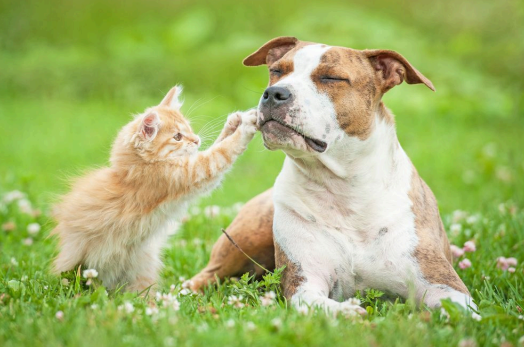
Too Hot To Handle: Protecting Your Pets From Heat Exhaustion And Heat Stroke
Summer is here, and your pets are ready to enjoy the sunshine right alongside you – whether it’s beach trips, backyard barbecues, or long afternoon walks. But as the temperature rises, so does the risk of heat-related illness like heat exhaustion and heat stroke in our furry friends.
With heat waves becoming more frequent and intense, it’s more important than ever for pet owners to understand how heat affects animals, recognize the early signs of overheating, and take steps to prevent serious emergencies.

Summer Danger: How Heat Affects Our Pets
It doesn’t necessarily have to be ‘hot’ for our pets to get heat stroke. Exercise in warm weather, or being stuck in a hot, humid, environment with poor ventilation can easily cause over-heating, or Hyperthermia.
Temperature range for dogs:
– Normal: 99.5℉ – 102.5℉
– Hyperthermia: 103℉ – 106℉
– Severe Hyperthermia/Heat Stroke: 107℉ – 109℉
Temperature range for cats:
– Normal: 100.5℉ – 102.5℉
– Hyperthermia: 103℉ – 104℉
– Sever Hyperthermia/Heat Stoke: >104℉
Dogs, cats, and other small mammals are not able to regulate their body heat like we can. Dogs in particular, have a very low number of sweat glands in their paw pads. Because of this, their main source of heat regulation is panting.
Heat Exhaustion vs. Heat Stroke: What’s The Difference?
Heat exhaustion and heat stroke are both heat-related illnesses, the only difference being that heat stroke is more serious and requires immediate medical intervention. If not treated by a veterinarian, heat stroke can cause the organs to fail – and in severe cases – can cause death.
Signs Your Pet Is Overheating
If your pet is experiencing any of the following symptoms, please contact our team right away:
Early Signs of Heat Stroke
– Panting (can progress to distressed/difficult breathing).
– Restlessness.
– Drooling.
– Red gums or tongue.
– Increased heart rate.
– Sudden onset vomiting or diarrhea.
Signs of Advanced Heat Stroke:
– Lethargy.
– Confusion.
– dry/sticky/bruised gums.
– Weakness or collapse.
– Seizures.
It is very important for pet parents to note that these signs can be observed in cats, but they are often more subtle.
Which Pets Are At Higher Risk?
Some of our furry friends are more at risk for developing heat stroke and heat exhaustion. If you have a pet like this, please take extra caution!
– Brachycephalic breeds (flat faced dogs and cats – pugs, bulldogs, himalayan or persian cats, etc.).
– Overweight pets.
– Pets with thick coats (german shepherds, huskies, etc).
– Geriatric pets and young puppies/kittens.
– Pets with pre-existing conditions (heart disease, lung disease, airway issues).

How To Keep Your Pets Cool And Safe
The easiest way to keep your pets safe is to avoid situations that put them in danger. Never leave your dog or cat in a parked car, even if the windows are rolled down! Make sure that whenever your furry friend is spending time outdoors that they have adequate access to shaded areas, and that they always have fresh, cool water available. Limit vigorous exercise during the hottest parts of the day, and save long walks for the morning or evening.
Emergency Action: What To Do If You Suspect Heat Stroke
If you believe that your pet is showing signs of heat stroke or heat exhaustion, the first thing you should do is contact Dr. DeForge and our team. We will give you the best instructions to keep your loved one safe and comfortable. If you cannot reach us, please call a 24/7 emergency center like VCA Shoreline ((203) 929-8600) for medical attention. Do not wait!
Steps you can take at home:
– You can try to bring your pet to a cooler area, but do not force/rush movement. If your pet is immobile you can bring a fan to them.
– Evaporation Method: you can pour small amounts of cool water onto your pet while cooling them with a fan. Do not fully submerge, or pour large amounts of ice-cold water onto an animal! This can cause shock and death.
– The main goal is to have your pet as stable as possible prior to taking them anywhere. However, make sure you are getting any and all advice directly from Dr. DeForge. Even if your pet seems back to normal, make sure to bring them in for a check-up to confirm they are okay.
Busting the Myths: Common Misconceptions About Heat Stroke In Pets
Sometimes, the facts can get twisted, and there is confusion about what is truly safe for our pets. As your veterinary team, it is our job to provide all the information needed to make the best decisions for the animals we all love! Listed here are some of the most common misconceptions about heat-related illness – and the true facts!
Myth: My pet is fine in the car for a few minutes with the windows cracked.
Truth: A car can reach deadly temperatures in minutes, even with the windows open. Pets should never be left unattended in a vehicle – period.
Myth: If my dog isn’t running around, they can’t overheat.
Truth: animals can suffer heat stroke even when resting, especially if they’re in a hot environment with limited airflow and/or shade.
Myth: Spraying them with water or giving them ice cubes is dangerous.
Truth: Cooling your pet appropriately is essential. Lukewarm water baths or wet towels are ideal. Small amounts of cool water or icecubes to lick are perfectly safe – just avoid shocking their system with excessive ice-cold immersion.
Myth: Only dogs get heat stroke.
Truth: Cats, rabbits, and other small animals are also at risk, especially if kept in hot, poorly ventilated environments. Cats in particular rarely show symptoms of pain, discomfort, or illness until they are in a more severe condition. It is critical to keep a close eye on all pets when the temperature rises!
Myth: Panting means my pet is cooling off fine.
Truth: While panting helps regulate temperature, excessive or labored breathing is a warning sign of overheating. Cats rarely pant, so open-mouth-breathing is a big sign that something is wrong – even if it is not necessarily heat-related.
If you ever have questions regarding your pets health or safety, do not hesitate to reach out. Our team will do everything possible to ease your stress and give you helpful, relevant information.
Summer Fun, Safely Done
Keeping your pet cool, hydrated, and safe during the summer isn’t just about comfort – it can be lifesaving. By recognizing the signs of heat-related stress, taking preventative steps, and staying informed, you can ensure your furry friend enjoys the season without risk. When in doubt, always err on the side of caution – and reach out to the Silver Sands Veterinary team if you’re ever concerned.
A safe summer is a happy summer for both you and your beloved pet!
